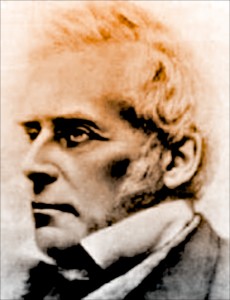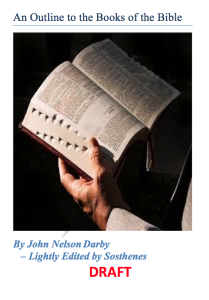The Body of Christ (the Assembly here) and the House of God (Christian Profession)
Based on a Paper by J N Darby – ‘The House of God; the Body of Christ; and the Baptism of the Holy Ghost.’
JND Collected Writings Volume 14 (Ecclesiastical 3) p15 –74

Throughout Christendom, in both Roman Catholic and Protestant circles, there is confusion as to the difference between the house of God and the body of Christ. The error that is rampant throughout Christendom, is that these two things are regarded as essentially the same, and that membership of a church gives a person all the privileges and blessings of Christianity.
We have to distinguish between:
- The Body of Christ This comprises living members on earth, born of God, quickened of the Spirit, with all their sins forgiven. They have been perfected by one offering and are heirs of the inheritance of glory.
- The House of God, a more general concept, encompassing the whole Christian environment or profession. Many are brought into it by birth.
If the house and the body were the same thing, all persons attending a church, adults or infants, believers and unbelievers, would be regarded as saved and members of the body of Christ. There would be no value in the death of Christ or the gift of the Holy Spirit.
The Assembly or Body of Christ
In the New Testament we have the word ἐκκλησία/ekklésia/Strong 1577 This is translated as ‘church’ in the King James Bible, and in most other modern English translations. In our minds when people use the word ‘church’ they would think of a physical building, or a particular denomination. Calling a physical church building a ‘house of God’ adds to the confusion.
It is for this reason that J N Darby preferred to use the word ‘assembly’- (see Matt 16:18 Darby Version). This is a more literal rendering of the Greek word (ἐκ-κλησία/ek-klésia = out-called = a-sembled). Where two or three are gathered together in Christ’s name, He is in their midst – that is the true church. Darby noted that the rendering was better in other languages, the word in German, Gemeinde, the word normally used for ‘community’. The French église, and Welsh eglwys come directly from the Greek.
He also noted the words used in the Old Testament.
- Qe-hal or kahal (Strong 6951)– congregation or assemblage – Strong uses convocation (See 2 Chron 30:25)
- Mo-w-ed or moed (Strong 4150) – the appointed place of meeting where they met God (See Ex 33:7)
- Ha-ed-ah or hedah (Strong 5712) – congregation or assembly – a company formed together by appointment (See Ex 12:3)
Israel was the assembly of God, but having rejected the Messiah, it is set aside, we might say, by the death of Christ. Israel failed in its witness of the unity of the Godhead, by the adoption of idolatry. So when the Lord Jesus came, Israel as a nation failed to recognise God’s visitation, and rejected Him.
From the time of the prophets onwards, God has always had a remnant of Israel who were devoted to Him. Prophecy looked forward to a remnant which would be preserved and brought back in the last days.
In Psalm 22 we have the Lord’s death as seen by the remnant (the seed that would serve Him v. 30). The Lord was to be been forsaken, and then heard of God – answereed from the horns of the buffaloes (or unicorns) (v. 21). The response is ‘I will declare thy name unto my brethren: in the midst of the congregation [kahal] will I praise thee (v. 22). This corresponds to Lord declaring to Mary Magdalen, ‘Go to my brethren and say to them, I ascend to my Father and your Father, and [to] my God and your God’. (John 20:17). What delight God has is in the value of His sacrifice when sin is put away.
In Matthew 16:19, Peter is given the keys the keys of the kingdom of heaven: he is not given the keys for the church (assembly). The church has no keys. Neither Matthew nor Peter give us teaching as to the assembly. We have the house – Peter, in his epistle says, ‘Ye also, as lively stones, are built up a spiritual house, an holy priesthood, to offer up spiritual sacrifices, acceptable to God by Jesus Christ’ (1 Peter 2:5).
For teaching as to the assembly we have to come to Paul: ‘The Head, from which all the body by joints and bands having nourishment ministered, and knit together, increaseth with the increase of God (Col 2:19). Whereas Peter sees things here, Paul sees the centre in heaven, where the Head is now.
When the Holy Spirit came, we have many Jews converted – 3000 in one day. Soon after in Acts, we have the introduction of the Samaritans, and then the Gentiles. Christians were persecuted, culminating in their rejection of Stephen’s testimony to Christ in heaven, ‘Behold, I see the heavens opened, and the Son of man standing on the right hand of God’ (Acts 7:56). Paul is converted having witnessed Stephen’s martyrdom and testimony, and in what the Lord said to him from heaven, ‘I am Jesus whom thou persecutest’ (Acts 9:5). Thus Paul received the light of the living body united to the Head in heaven, and us seated in the heavenly places in Christ (see Ephesians 1:20). Paul also showed that the body comprised living members, all fitted together perfectly – no dead members, and not a mutilated body. That is the body of Christ here.
The Church in a Scene of Responsibility Here
Israel had failed in responsibility: now we see the Church in responsibility now. It is important to see that the house has been is established, because in the house there can be failure even to apostasy. On the other hand, the assembly cannot fail, because Christ is ‘head over all things to the church, which is his body, the fulness of him that filleth all in all’ (Ephesians 1:22-23). As Head over all things to the assembly Christ, the glorious Man, is Prophet, Priest and King. Whereas man had failed, you have Christ such perfection that He will be ‘glorified in his saints, and to be admired in all them that believe’ (2 Thessalonians 1:10).
In Ephesians 1:1 to 2:10, we have the assembly according to the purpose and counsel of God, There is no dependence on man. Paul’s prayer was ‘That the God of our Lord Jesus Christ, the Father of glory, may give unto you the spirit of wisdom and revelation in the knowledge of him: the eyes of your understanding being enlightened; that ye may know what is the hope of his calling, and what the riches of the glory of his inheritance in the saints, and what is the exceeding greatness of his power to us-ward who believe, according to the working of his mighty power, which he wrought in Christ, when he raised him from the dead, and set him at his own right hand in the heavenly places, (Ephesians 1:17-20).
From Ephesians 2:11 we have the actual condition down here. It is being built on the foundation of the apostles and prophets, Christ being the cornerstone, and what is being built is the dwelling place of God through the Spirit. In Ephesiuans Paul refers much to the mystery, and it can be seen in the church livingly here. Augustine spoke of an invisible church, and this is still referred to, but this is not invisible. There is the outward manifestation of the church its unity, recognition of the work of the Spirit of God on earth. We see it in the gifts (apostles, prophets, teachers) which have been given in the whole (not the local) assembly. They are placed in the assembly, on earth, among ‘them that are sanctified in Christ Jesus, called to be saints’ (1 Corinthians 1:2).
The Assembly as God’s Habitation
The second aspect of the assembly in Ephesus is a dispensational one. Christ builds an assembly secured from Satan’s power. We have the assembly according to the councils of God God workmanship in an ordered condition – not as what it has become was in the hands of man. We have in Ephesians ch 1-2, facts rather than opinions – Jews and Gentiles made nigh by the blood of Christ, the middle wall of partition broken down, and all reconciled into one body by the cross, and formed together growing to a holy temple in the Lord. This is a work going on in grace on earth – God’s habitation by the Spirit. It does not say that God animates and unites believers, but He has a place where He dwells. Unity will result.
In chapter 4 we are told walk in love, worthy of the calling, and to use diligence to keep the unity. We are given the unity from God’s point of view ‘There is one body, and one Spirit, even as ye are called in one hope of your calling; one Lord, one faith, one baptism, one God and Father of all, who is above all, and through all, and in you all’ (Ch 4:4-6). This is not the view according to man’s responsibility that we get in 1 Corinthians 3:12. There you get what is being built on the good foundation – good things – gold, silver, precious stones, and worthless things – wood, hay, stubble. All man’s bad building will be lost. In 2 Timothy 2, we get the great house – with vessels to honour and dishonour also those professing Christians with the form of godliness but denying its power. The true believer to is to purge himself (or turn away), from these and follow righteousness, faith, love, peace, with them that call on the Lord out of a pure heart. (see 2 Tim 2:21-22 and 3:5).
After the rapture the apostate church will remain, led by the man of sin.
Summary
In summary, these scriptures referred to give us a clear view of the way the church is presented:
- The body according to the purpose and work of God, its members quickened with Christ, raised up and sitting in heavenly places in Him.
- The body manifested on the earth by the baptism of the Holy Spirit (not water), outwardly expressed by union in partaking of the Lord’s supper.
- The spiritual house in the thought and purpose of God, built on the foundation of apostles and prophets of the New Testament, growing up a holy temple to the Lord.
- The building of this house in fact by the labours of man. Paul might have been the wise master-builder; but there were others not building with good materials.
- The great house with vessels to dishonour to purify themselves and turn away.
- Finally, after the rapture, the actual apostasy ending in judgment.
What Church Leaders have Taught
In the subsequent thirty pages of the paper, J N Darby looks at the writings of the various church fathers starting just after the apostolic period (Barnabas, Clement etc) up till the eighteenth century – Catholic, Protestant and Orthodox. If you wish to read this in detail, it is in the original article, starting at page 39.
Here is a Summary of happenings in the Great House:
In short, almost nobody saw the assembly in its heavenly character according to the purpose of God. This was because most walked by sight. Water baptism became the method of entry, this being held by most. And the house of God was taken to be he physical building. Many considered being a member of the church as being the same as salvation. They acquiesced in evil, quoting the parable of the wheat and the tares – God would have it all right in the end. Priests became mediators. That was supposed to be Christianity!
Sosthenes
January 2018


